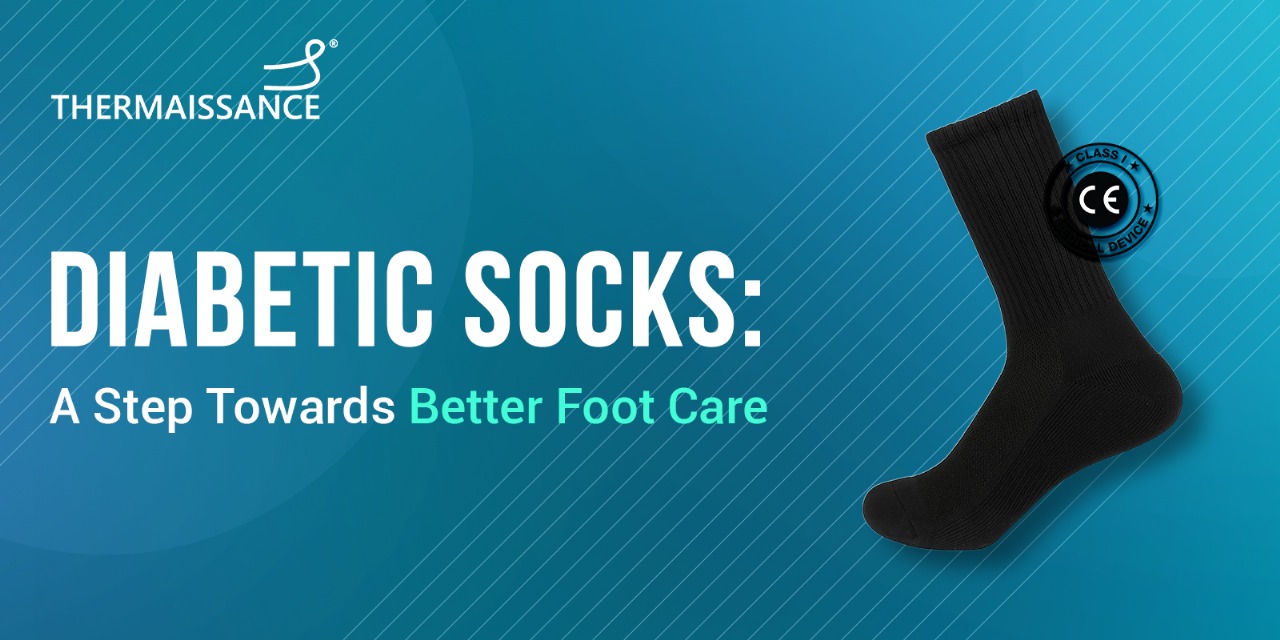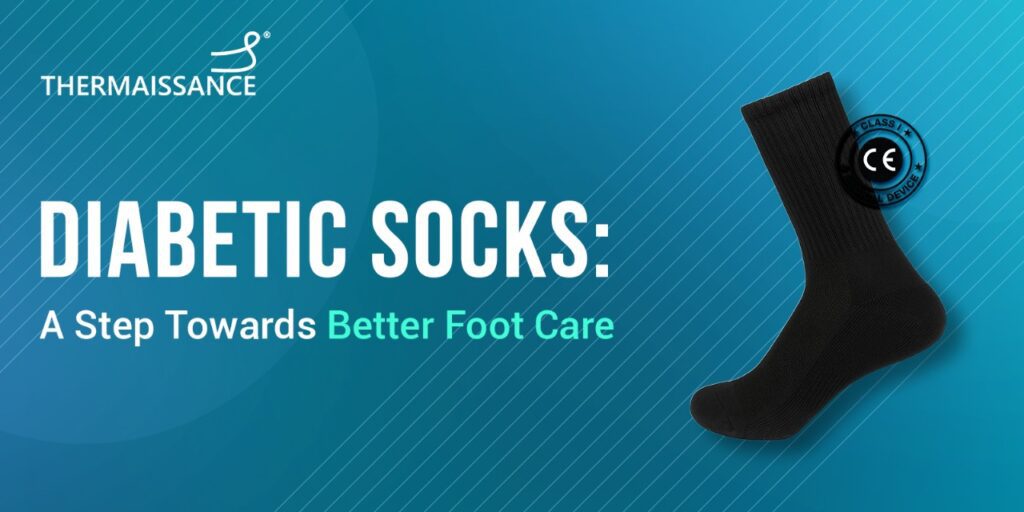

Diabetic Socks: A Step Towards Better Foot Care When people think of diabetes, they normally think of glucose monitors, sugar-free diets, or injections of insulin. In reality, the real danger for millions of people around the world begins at the foot, making diabetic foot care a critically important aspect of living well with diabetes. Foot complications are among the frequent and serious consequences of diabetes. A 2024 study published by Springer Medicine indicates that nearly 6.2% of diabetic patients in India suffered from diabetic foot ulcers, which can ultimately lead to amputation in some cases. This number grows to 17.1% worldwide according to ScienceDirect.
Why Should Diabetic Foot be Prevented?
Diabetes affects nerves, blood vessels, leading to neuropathy, and macrovascular disease. In turn, blood circulation decreases, and even minor injuries do not heal well, which magnifies the chance for ulcers, infections or even amputation.
The incidence of foot-related complications in persons with diabetes include:
- Foot ulcers — these begin as small sores which do not heal, through frequent, prolonged friction, excessive pressure, or injury that may not be visible to the person affected.
- Infections — bacterial or fungal infection is either superficial or deep from cuts the patient received during daily activities or from a blister due to excess moisture, or a lack of general immunity.
- Foot deformities — weakness of nerves resulting in weakness of muscle control, leading to claw toes or flat, collapsed arches are common deformities found in persons with diabetes.
- Gangrene — a very serious state of tissue damage from tissue death due to prolonged lack of blood flow.
At the community level in urban India, one community health level study reported an incidence rate of 66 DFU patients per year with persons diagnosed with diabetes per 10,000 individuals, and 15.29 of the total DFU at this time point required amputation during the study period PMC.
Why Regular Socks Are Not Sufficient
We rarely think about whether our socks are doing enough. But for someone with diabetes, wearing the wrong socks can potentially make matters worse.
- Uneven or tight elastics in conventional socks can restrict already fragile circulation, creating pressure rings that worsen edema and blood flow. On the other hand, loose socks without elastic support tend to slide down, causing friction and bunching — a major source of microtrauma and blistering.
- Rough seams and thick stitches can dig into insensitive skin, leading to unnoticed cuts or abrasions that may turn into ulcers.
- Non-breathable synthetic fabrics trap moisture, encouraging bacterial and fungal growth, while even ordinary cotton can stay damp and increase infection risk.
A few minor irritations may feel harmless, but for someone with diabetic neuropathy or peripheral vascular disease, these small micro-traumas may not be felt until they start to progress and end up requiring wound care. That’s why diabetic socks must strike the perfect balance — firm enough to enhance microcirculation, yet gentle enough to avoid compression injury.
There are many that are at risk for infections and hospitalization simply from a neglected blister. Increased time healing, reduced acute sensation, and poor circulation are the three things that change small issues in diabetic foot into serious problems.
Everyday diabetic foot care, regular check-ups, and wearing protective diabetic socks, are more than a lifestyle commodity, they are prevention and health measures.
Where Smart Design Meets Preventive Care
That’s where Thermaissance’s Smart Diabetic Circulation Socks redefine what protection feels like. These aren’t ordinary socks with added comfort — they are CE Class I Medical Devices under the European Union Medical Device Regulation (EU MDR), clinically validated to enhance microcirculation, maintain hygiene, and protect sensitive diabetic feet.
They are made using smart textile technology and designed to do five crucial things:
Thermoregulatory Fabric:
The fabric’s smart fibers adapt to body temperature — keeping feet comfortably warm in cooler conditions and preventing overheating in warm environments. Controlled warmth helps improve vascular responsiveness in diabetic feet.Moisture-Wicking System:
Sweat and dampness are quickly drawn away from the skin, eliminating the breeding ground for fungal infections.Antimicrobial Shield:
Clinically proven antimicrobial technology — tested in ICMR-approved and NABL-accredited labs — reduces microbial growth and odor, maintaining a clean microenvironment around the foot.Seamless, Cushioned Comfort:
Advanced knitting eliminates harsh seams and pressure points, providing uniform cushioning that reduces friction and improves sensory comfort.Intelligent Support:
The socks feature a scientifically calibrated, wide-band elastic that holds them firmly in place — snug enough to encourage healthy blood flow, yet
Unlike ordinary socks that simply cover your feet, Thermaissance Smart Diabetic Circulation Socks actively work with your body’s physiology — improving comfort, circulation, and protection with every step.
Small Actions, Big Change
Of course, no product can replace awareness. In addition to wearing proper socks, here are a few good habits every person with diabetes should consider keeping top of mind:
- Check your feet daily. Look for redness, blisters, cracks, or swelling, even between your toes.
- Wash with soap and lukewarm water. Hot water, for instance, will burn your numb feet and you won’t realize it.
- Keep them dry and moisturized. Moisture between your toes is a bad idea but dry, cracked skin is open to infection.
- Never go barefoot. Even indoors — a small stone or an edge can cause damage.
- Trim the nails correctly. Straight across and not too deeply, or, to be safe, see a podiatrist.
- Change socks every day. New, dry socks are a good step to keep bacteria from growing on your foot.
Walking Forward with Confidence
The narrative of diabetes doesn’t need to be framed in terms of restrictions and fear. With the right knowledge and your care tools, diabetes can be framed in terms of empowerment.
A pair of smart diabetic socks may not cure diabetes, but they will help reduce complications that rob you of movement and independence. Think of it like a daily routine – like brushing your teeth or checking your sugar, it should contribute to you being able to walk better, longer, and more comfortably.
Diabetic foot care is preventive health at its most practical. Because sometimes, the most powerful changes start with the smallest steps, or in this case, what you wear on them.
Recent Posts
-
30 Oct 2025 ThermaissanceWhy Contaminated Linen is the Most Underestimated Threat in the Fight Against Hospital Acquired Infections
-
28 Oct 2025 ThermaissanceDefeating Neonatal Hypothermia: How the Thermaissance Baby Hug Revolutionizes Thermal Management for Preterm Infants
-
 25 Sep 2025 ThermaissanceDiabetic Socks: A Step Towards Better Foot Care
25 Sep 2025 ThermaissanceDiabetic Socks: A Step Towards Better Foot Care
